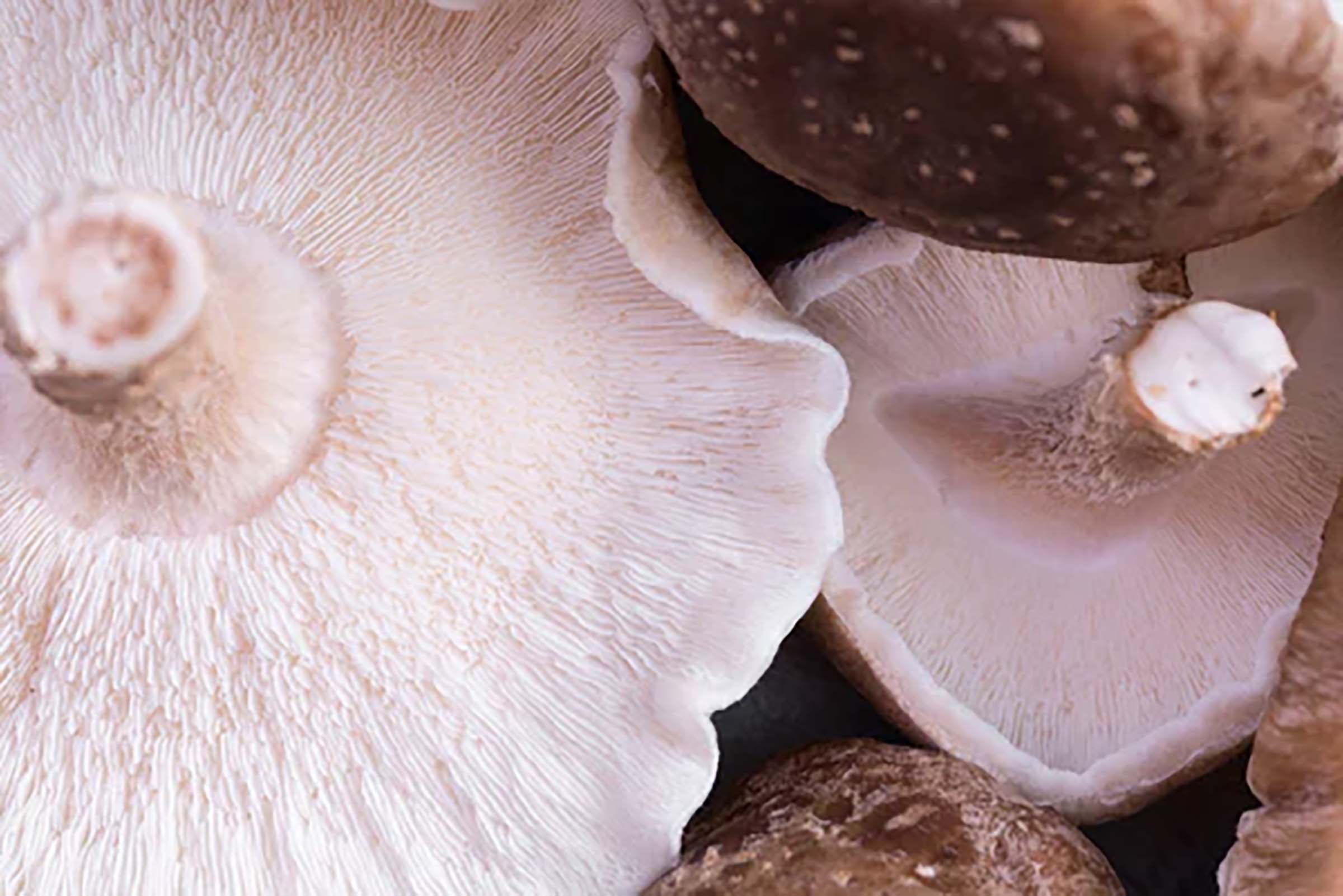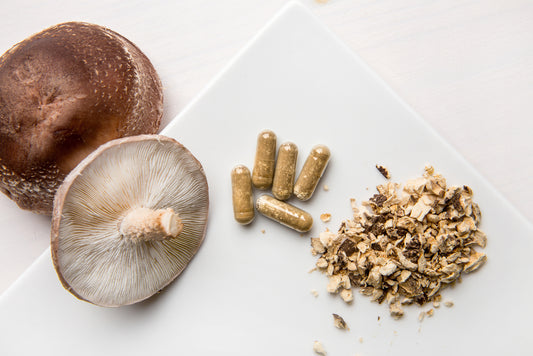Mushrooms are fascinating organisms with a complex anatomy made up of several parts. Mushrooms belong to the Kingdom (or Queendom) Fungi. There are millions of different species of fungi, that can be divided into two major groups: macrofungi and microfungi. Microfungi are tiny organisms often living in other organisms, such as yeast or molds. Conversely, macrofungi are visible to the naked eye and typically have a fruiting body and root-like structures known as mycelium.
This article aims to provide a brief overview and understanding of mushroom anatomy, particularly macrofungi. It will also cover some fascinating facts about mushrooms, such as their classification as a species and the remarkable genetic similarities they share with humans. Finally, we will discuss the potential health benefits of functional mushrooms and recommend a few mushroom blends to get you started on a new path to better health and wellness.
An Overview of Mushrooms
While many mushroom species are microscopic and invisible, the visible ones, such as morels, chanterelles, corals, and puffballs, come in a variety of shapes and sizes. To keep things simple, we'll start with the most well-known mushroom, Agaricus bisporus, also known as a button mushroom.
Agaricus bisporus has a fruiting body, which is the visible portion of the mushroom above ground that produces sexual spores that are dispersed by rain, wind, and/or animals. The mycelium is the mushroom's vegetative part that grows underground and feeds on organic matter. It spreads by enlarging its network of thread-like cells known as hyphae, which secrete enzymes that break down surrounding plant material that the mushroom can absorb. When the mycelium has gathered sufficient nutrition from the substrate material that it is enzymatically digesting, and environmental conditions are right, the hyphae (filaments of mushroom mycelium) organize themselves to construct a mushroom fruiting body. A mushroom fruiting body is composed of mushroom mycelium that has been organized into a distinct structure as compared to the mycelium’s network-like structure. Although the mycelium and fruiting bodies of mushrooms are often compared to the roots and fruit of plants, this comparison is problematic because the differences in types, functions, and content of cells in plants is much more pronounced than in mushrooms. Mushroom mycelium organizes itself to become mushroom fruiting bodies.
Every part of the mushroom works together to complete the mushroom's life cycle and ecological role. Mushrooms frequently form mycorrhizal associations1 with certain plant species, assisting the plants in absorbing nutrients from the soil. Mushrooms also play an important role in the natural decomposition of organic matter, aiding the breakdown of dead plant and animal matter into nutrients.
Mushroom Anatomy and Benefits
When you think of a mushroom, the fruiting body, or the edible part that grows above ground, is likely what comes to mind. However, mushrooms are more complex than what meets the eye.
The cap (or pileus), gills, stalk, and ring (annulus) are all fruiting body structures. The cap is the top part of the mushroom, and it protects the gills and reproductive spores from direct sunlight and wind. The gills are thin, blade-like structures that expand outwards from the stem and line the underside of the cap. The mushroom's stalk supports the cap and connects to the mycelium root-like structure under the ground.
The ring (or annulus) is a structure that protects the developing mushroom as it emerges from the ground and allows spores to disperse. When the fruiting body matures, it then releases spores into the air, which can be carried to new locations by wind or other means. Some of these spores will settle in viable conditions and begin to germinate. Once the haploid spores germinate, they must “mate” with a compatible spore type to be able to complete the mushroom life cycle.
This process will result in the formation of new mycelial networks and, eventually, the sprouting of new fruiting bodies. In this way, all parts of the mushroom work together to ensure the species' survival and spread.
|
Mushroom Part |
Description |
|
Cap (pileus) |
The mushroom's top is usually round or oval, with a smooth, slightly curved surface. |
|
Gills |
The thin, blade-like structures that radiate from the stem and line the underside of the cap, where the spores form. |
|
Stalk |
The vertical, cylindrical structure that supports and connects the cap to the mycelium. Its surface is usually smooth or slightly rough. |
|
Ring (annulus) |
The thin, membranous structure encircles the stem near the cap. When the mushroom is young, the remnant of the partial veil covers the gills. |
|
Bulb |
A cup-like structure that can form at the stem's base. When the mushroom is still underground, a sliver of the universal veil encircles it. |
|
Mycelium |
The underground thread-like network of fungal cells that feeds on organic matter. The mushroom's vegetative part gives rise to the fruiting body. |
|
Spores |
The gills produce microscopic reproductive cells, which are dispersed by the wind. They serve as a means for the mushroom to reproduce and spread. |
The Science of Mushrooms
Mushrooms belong to the Kingdom Fungi, which includes other organisms like yeasts, molds, and lichens. Fungi are distinct from plants, animals, and bacteria, and they play a vital role in the ecosystem by breaking down tough organic material and recycling nutrients in the environment.
Despite their importance in various ecological niches, fungi often go unnoticed due to their inconspicuous nature, earning them the nickname “The Forgotten Kingdom." However, fungi play a crucial role in supporting life on our planet. For example, the Basidiomycetes phylum is particularly important in carbon cycling and serving as symbiotic partners with other organisms.2 Basidiomycetes are essential for human use as a valuable food source and are becoming increasingly significant in medicinal research.3
While the evolutionary history of fungi is still being researched, scientists believe fungi diverged from other eukaryotic organisms around a billion years ago. In fact, fungi and animals are thought to have shared a common ancestor and are more closely related than plants.4 Because of our genetic similarities, researchers believe that studying mushrooms could reveal unexpected insights into human genetics, disease, and new medical treatments.
Health Benefits of Functional Mushrooms
For thousands of years, humans have consumed wild and cultivated mushrooms for their nutritional and medicinal benefits. Mushrooms are high in protein, carbohydrates, and dietary fiber, and they also contain vitamin D, trace elements like potassium, and vitamins like riboflavin, niacin, and folate.5
Functional mushrooms are a distinct subcategory of edible mushrooms that contain medicinal properties. They differ from other mushrooms because they are specifically grown for their medicinal properties and can be sold in different formats, such as powders, capsules, and even mushroom gummies.
They have also been discovered to have potential benefits for brain function, health, and vitality. Lion's mane mushrooms, for example, contain compounds that can stimulate nerve growth and support cognitive function. Cordyceps mushrooms have been shown to improve exercise performance by supporting oxygen consumption and delivery (VO2 Max).‡
Functional mushrooms can provide significant health benefits. Numerous in vitro and in vivo studies have evaluated the pharmacological properties of mushrooms. These studies have shown that mushrooms can provide several health benefits, including antioxidant, immune supporting and gut balancing effects.5 Therefore, consuming mushrooms as part of a daily diet is recommended for improved health and wellness.‡
Introducing Functional Mushrooms Into Your Daily Diet
Mycology (or the study of fungi) is a fascinating field that constantly discovers new potential uses for mushrooms in our environment and as natural remedies. While mushrooms have a long evolutionary history and are widely used in traditional medicine, we expect future scientific research to reveal even more ways mushrooms can benefit our health and well-being.
Mushrooms are a powerhouse of health benefits, boasting immune- and energy-supporting properties, cognitive enhancement, and even skin health benefits.‡ With Om Mushroom Superfood, it's now easier than ever to incorporate the benefits of functional beverages into your daily routine.
Om Mushroom supplements are made from whole-food mushrooms that contain a full spectrum of naturally occurring nutrients found throughout the mushroom anatomy, including the fruiting body and mycelium. Discover the incredible health benefits of mushrooms with Om Mushroom Superfoods today!
Om Mushroom offers products created from functional, whole food, organic mushrooms with life-changing health benefits. Our products contain the proper mushroom dosage to enhance your body’s natural immune functions. If you want to take advantage of the benefits of functional mushroom products, shop now or subscribe to save!
‡These statements have not been evaluated by the Food and Drug Administration. Functional mushroom products are not intended to diagnose, treat, cure, or prevent any disease.
Resources:
- Soudzilovskaia, N.A., Vaessen, S., Barcelo, M., He, J., Rahimlou, S., Abarenkov, K., Brundrett, M.C., Gomes, S.I.F., Merckx, V., & Tedersoo, L. (2021). FungalRoot: global online database of plant mycorrhizal associations. New Phytologist, 229(2), 853-858. https://doi.org/10.1111/nph.16848
- de Mattos-Shipley, K. M. J., Ford, K. L., Alberti, F., Banks, A. M., Bailey, A. M., & Foster, G. D. (2016). The good, the bad and the tasty: The many roles of mushrooms. Studies in Mycology, 85, 125-157. https://doi.org/10.1016/j.simyco.2016.11.002
- Sciencedirect.com. (n.d.). Basidiomycete. In Topics in Immunology and Microbiology. Retrieved May 3, 2023, from https://www.sciencedirect.com/topics/immunology-and-microbiology/basidiomycete
- Phys.org. (2006, October 30). Evolution of fungi and their relatives. Retrieved from https://phys.org/news/2006-10-evolution-fungi-relatives.html
- Reis, F. S., Barros, L., Calhelha, R. C., Ćirić, A., van Griensven, L. J. L. D., Soković, M., & Ferreira, I. C. F. R. (2011). Biomolecules and nutritional value of the ectomycorrhizal mushroom Tricholoma portentosum. Journal of the Science of Food and Agriculture, 91(1), 172-178. https://doi.org/10.1002/jsfa.416











